Blog
Study Finds a Significantly Reduced Fracture Rate for Falls on SmartCells Cushioning Technology
- Derek Hawn
- April 3, 2013
- 8:00 am
- No Comments
- 2 minutes
Falls in older adults are associated with significant morbidity and mortality. Older adults living in nursing homes are three times as likely to fall as those living in the community. Rapp et al estimated the rate of falls to be about 1.6 per nursing home bed per year. Falls in this population lead to fractures approximately once every 20 falls. Beyond the significant impact falls have on the resident, falls with injury are also responsible for about 60% of liability cases filed against nursing homes.
Since 1988, numerous studies have suggested that the wearing of hip protectors can reduce the fracture rates related to falls. A recent Cochrane review, however, found only a marginally significant reduction in hip fracture risk in the use of hip protectors in nursing homes, but not in the community. Furthermore, compliance with the wearing of hip protectors is not very high.
An alternative approach to having each resident wear a hip protector could be to design a safer floor. Dual-stiffness flooring (DSF) has a rigid top layer and a collapsible lower layer. The intent is that the top layer provides support like a regular floor, while the collapsibility of the lower layer acts as a shock absorber. A number of biomechanical studies have suggested that DSF diminishes the impact of contact with a floor, potentially reducing injuries associated with falls. More recent studies have further supported these findings in people.Given that about 75% of falls in a nursing home occur in residents’ rooms, including the bathroom, it would make sense to install DSF in residents’ rooms. To our knowledge, there are no publications to date from a controlled study comparing injury rates on regular flooring with that on DSF in a nursing home setting.
Results
Over the study period, there were 449 documented falls. There were 82 falls on the DSF, and these were compared with the first 85 identified by taking every third of the remaining 282 falls on regular flooring. Fallers had a mean age of 74.2 years; 53% were male and 24% were on medication for osteoporosis. On average, these patients took 10 medications. Fifty-five percent of falls resulted in an injury and 26% in a significant injury, defined as abrasion, cut, fracture, or two or more injuries. Patients allocated to DSF flooring rooms were comparable with their counterparts in the regular flooring rooms on the previously mentioned factors except that they were significantly younger and took significantly fewer medications; these factors were thus treated as covariates in the analyses. There was a marked tendency for residents falling on DSF to have less bruising and abrasions while having more redness and cuts. There were two fractures on regular flooring (2.4% fracture rate) and none on the DSF flooring (0% fracture rate).
The complete report can be found here:
Dual Stiffness Research Report
Falls Happen. And They are Costly.
Fall Protection for Seniors in the Home and at Care Facilities
Holiday Tips to Keep Elderly Loved Ones Healthy and Safe
Treat Your Feet: How Maintaining Healthy Feet Reduces Falls
Unique From The Ground Up – The SmartCells Difference
Case Study: SmartCells Flooring Keep DOD Pharmacists Comfortable
The SmartCells Solution: How to Successfully Manage Increased Holiday Demand
7 Tips for a Fun and Safe 4th of July
SmartCells: Proudly Made in the USA
6 Ways to Get the Most Out of Your HIIT Workout
Let us help you find the right solution
Not sure where to start? Our customer service and sales representatives – who are just as knowledgeable about the product as the scientists who created it – would be happy to help you understand more.



